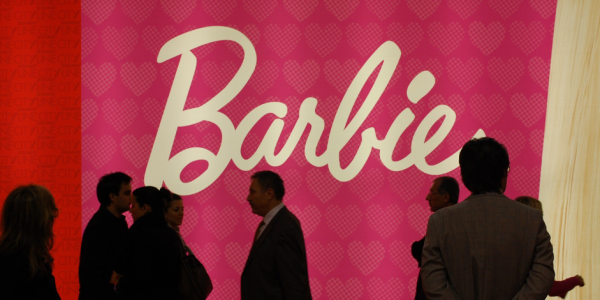Plastic breaker of box office glass ceilings, Barbie was born a camp classic where even the patriarchy is rose-tinted.
By Joanna Burigo
Satirical self-awareness, countless references to classic movies, and a witty script built on feminist quips and jokes about the patriarchy help make Greta Gerwig’s Barbie a perfect feel-good film to watch during this year’s holidays. The film was born a camp classic owing to its ability to turn the serious into the frivolous with artifice and exaggeration, to paraphrase Susan Sontag’s Notes on Camp (1964), and projects key understandings of gendered power onto a doll, for the audience to play feminism with.
To ask if Barbie is a feminist, though, is akin to wondering whether Santa Claus is a capitalist; the answer is a resounding no, for they are both fictional characters who solely exist due to imagination. Still, Barbie the movie is poignantly centred on gender and power and works well as both an entertaining product and a social commentary on the permanence of cis white men at the centre of decision-making. The first woman-directed Hollywood feature-length film to earn US$1 billion, Barbie has since steadily followed the pink plastic road to herstory as the highest-grossing movie of 2023. The business of marketing feminism as a product or brand value is no novelty, and Barbie does not inaugurate any mode of feminist trade[1] nor of the circulation of feminist ideas through reifying emphasised femininity[2].
Margot Robbie’s Stereotypical Barbie has it all… including an identity crisis and the need to fight sexism. We learn that her world is crumbling as she struggles with vulnerabilities that stem directly from gender norms, and the score that plays right as we are introduced to Barbieland – Lizzo’s Pink – reveals the transition from the doll’s illusion of a perfect life to the chaos of reality, setting the tone for the sequence in which she literally puts her feet on the ground for the first time. In this movie, overthrowing the patriarchy emerges as a feminist proposal; a collective task summoned by a woman who knows well that, contrary to the protagonist’s belief, the problems of feminism have not been solved. Together, the Barbies seek strategic help to smash the (simulation of) patriarchy that is the fleeting Kenland.
Barbie is an effective marketing piece because it understands postmodernity as the native language of a generation used to communicating in fragments of references. The producers bet on the selling power of self-conscious irony, and Barbie operates as an advert for the Barbie of the now, by mocking Mattel and humanising the doll. This might call into question its feminist intentions if it were a manifesto, but Barbie is a comedy that raises awareness of gendered oppression by showing that, for women under patriarchy, not even life in plastic is fantastic.
When Barbie and Ken appear in Los Angeles in outlandish outfits after first crossing the portal between their and our world, the pair reveal impressions based on how they are gazed upon. She is bothered by being aggressively sexualized; he reports feeling admired and respected; unquestionably white, neither is a victim of racism. Despite the diverse representation and mockery of the patriarchal order — with no sign of reproductive work and a 100% female Supreme Court — race, class, rights, and politics are blind spots in this farce about hegemonic power and images. As the story unfolds, the patriarchy becomes a villain, called by its name though not expounded as a concept. Ken even mansplains it to Barbie in the typical confidence with which some dudes gloat about their own ignorance.
Photo by Maurizio Pesce from Wikimedia Commons
Ryan Gosling’s Disney background lulled him into what might be his most formidable performance to date, and Ken’s arc, musical numbers and style are drawn from cinematic imagery of hegemonic masculinity[3] over time. The Kenergy he exudes is pure camp perfection, embodying to absolute glory what Sontag described as a “mode of aestheticism that proposes a comic vision, a way of seeing the world as an aesthetic phenomenon not for beauty, but for the degree of artifice and stylization whose hallmark is the spirit of extravagance”. In addition to having “Beach” as a job, he is a cowboy surfer and pop star blend who vibes along the Gene Kelly dream sequence from Singin’ in the Rain (1952), serves John Travolta moves from Saturday Night Fever (1977) and Grease (1978), flaunts the sartorial flamboyance and muscle tone of Sylvester Stallone in Rocky (1976) and Rambo (several throughout the 1980s), and mirrors the rival camaraderie between Tom Cruise and Val Kilmer in Top Gun (1986), only here the high-fives and smouldering looks are exchanged in a sweatless volleyball match.
The film serves as a springboard to multiple perspectives, and Stuart Hall’s theories of reception help shed a light on this matter, particularly his communication model from “Encoding/Decoding” (1973), where he shows that one event can be coded in multiple ways, messages contain more than one reading, and understanding them can be vexing. British primatologist Jane Goodall, proud of her institute and Mattel for creating Barbies from plastic recycled from the oceans, posed with the one she inspired captioning the image with the movie’s promotional jargon “this Barbie believes that each individual can make a difference every single day”. Pakistani activist Malala Yousafzai entered the ubiquitous box made for theatres and social media with husband Asser Malik, and also posted the slogan (in her case, literal) “This Barbie has a Nobel Prize. He’s just Ken”. Canadian PM Justin Trudeau and his son went to the cinema in pink shirts claiming to be #TeamBarbie. Fundamentalists concluded it is not for children nor does it promote Christian values, and got both right: rated PG 13, the closest it gets to religion is by iconoclasm; Kens are as much an afterthought in Barbie’s world as women are in monotheism, and Barbie’s move into reality is completed when her hands are touched by those of her creator (Ruth Handler, played by Rhea Perlman), an obvious nod to the depiction of God giving Adam life in Michelangelo’s fresco at the Sistine Chapel.
The movie is also packed with meaningful secondary roles filled by a stellar cast of supporting actors. Gloria, the adult whose struggles wake the doll, was carefully sculpted by America Ferrera to deliver the film’s emotional apex through a monologue that cradles Barbie’s wokeness. Sasha, her teen daughter, is played by Ariana Greenblatt to resemble Bratz, and the generational altercation between the dolls engenders the best line of the script: “She thinks I’m a fascist? I don’t control the railways or the flow of commerce!”, Barbie sobs following the kid’s shallow accusation.
Screenshots taken by the author for analytic purposes. Left: Toy Story 3 (2010) Right: Kate MacKinnon in Barbie (2023)
Another great line uttered by a Barbie, albeit the one from Toy Story 3 (2010), is “Authority should derive from consent of the governed, not from threat of force!”, and Kate McKinnon’s Weird Barbie must be her direct descendant.
Sporting eccentric clothes, makeup and haircut, and always in splits, this Barbie thinks outside the box and welcomes the marginalised. It is in her mojo dojo casa house, in the presence of controversial figures like Sugar Daddy Ken and Barbie Video Girl, that the action plan is devised. Weird Barbie works as key to the conscience, heart and courage that Stereotypical Barbie needs to realise what she wants, which is to be “part of the group of people who create meaning, not something that is made”. If it is true that dolls reflect those who play with them, this movie gives high praise to kids who make radical projections onto theirs.
Much like Billie Burke as the good witch Glinda in The Wizard of Oz (1939) and Lawrence Fishburne as Morpheus in The Matrix (1999), McKinnon shines as the wise and misunderstood character who guides the journey of the hero. In his 1996 review of the Wizard, the late Roger Ebert noted the significance of the pair of ruby slippers as enablers of Dorothy’s return to Kansas/reality after following the yellow brick road to Emerald City/dream: they are grown up shoes. Neo, the Matrix main character, is famously presented with a choice between a blue or a red pill, the former meaning blissful ignorance, the latter a rude awakening in the desert of the real. It is not insignificant that the choice Barbie is presented with to move from plastic land to a human home is between pink high heels or flat brown Birkenstocks.
This behemoth of camp cinema winks at whatever feminist conflict there may be, while firmly placing emphasized femininity within the realm of childish fantasy. Smashing the patriarchy ain’t rosy and it can get weird, so Barbie better grow up and follow the feminist road.
 Joanna Burigo obtained her MSc in Gender, Media and Culture from the LSE in 2012. She currently lives in Brazil, teaching feminist, gender and media theory at La Salle University. She is the author of “Patriarcado Gênero Feminismo” (Zouk, 2022).
Joanna Burigo obtained her MSc in Gender, Media and Culture from the LSE in 2012. She currently lives in Brazil, teaching feminist, gender and media theory at La Salle University. She is the author of “Patriarcado Gênero Feminismo” (Zouk, 2022).
Profile picture credit: AJ Sanders, 2022.
[1] By “feminist trade” I mean monetary exchanges that also happen to be feminist; examples include but are not restricted to feminist perspectives carried out through book deals or feminist slogans put on apparel that is for sale. It is not the aim of this blog post to critique the movie as a product of “neoliberal feminism”.
[2] A concept that forms part of a general theory of the gender order, proposed by RW Connell.
[3] Also a concept that forms part of a general theory of the gender order, proposed by RW Connell.



